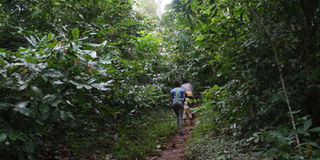Hybrid system can conserve sacred forests

An image of Giitune Sacred Forest Heritage Site in Ruiga, Imenti Central, on December 2, 2015. Though greatly debated, both indigenous and modern governance systems contribute significantly to protection of sacred forests. PHOTO | PHOEBE OKALL | NATION MEDIA GROUP
What you need to know:
- There is a need to define the appropriate governance of sacred forests through evaluation of indigenous and modern systems.
- Although hard evidence is lacking, it is increasingly clear that the status of many sacred forests is changing.
Sacred forests are the nerve centre of ecological, spiritual and cultural practices and governance systems of indigenous people and their sacredness depicts a sustainable pattern in relation to ecology, economic and social cultural aspects.
But indigenous people are, in most cases, denied access to natural resources, leading to ineffective governance in the management of the assets with the communities’ contribution to governance issues sidelined.
Though greatly debated, both indigenous and modern governance systems contribute significantly to protection of sacred forests.
There is a growing concern that adoption of modern approaches to governance of sacred forests is inadequate.
KNOWLEDGE
The same applies to indigenous governance systems — although more focus by stakeholders is to incorporate local communities and indigenous peoples in management of sacred forests.
The indigenous systems are important natural resources that facilitate knowledge for protection of the ecosystem in participatory, cost-effective and sustainable ways.
The systems are unique to a given culture or community and utilise indigenous knowledge for environmental governance decisions.
They are not only useful for the local communities but also scientists and planners.
EVALUATION OF STRATEGY
Indigenous knowledge forms a foundation of most social science thinking and development and there is a debate on the relative failure of externally introduced systems.
Though arguably not differentiated, it is said to be significant and introducing a cost-effective, participatory and sustainable development process in the governance of sacred forests.
Changing times, attitudes and practices have necessitated a re-evaluation of both systems.
Although hard evidence is lacking, it is increasingly clear that the status of many sacred forests is changing.
MANAGEMENT
There is a need to define the appropriate governance of sacred forests through evaluation of both indigenous and modern systems, exploring their opportunities and challenges.
Recent research by this writer with the Wangari Maathai Institute for Peace and Environmental Studies at the University of Nairobi last year established gaps in participatory forest management (PFM).
PFM is the modern form of environmental governance and indigenous governance systems represented by taboos, ritual, belief, fines, sacrifices and other indigenous practices that supported forest governance.
INTEGRATION
The November 2016 report, Opportunities and Challenges of Indigenous and Modern Governance Systems for Sacred Forests, proposes a system that integrates indigenous and modern systems, adopting a multiscalar action form or pointers of environmental governance.
These include principles of effective governance, namely: Integration, involvement, collaboration and accountability (IICA).
The hybrid or multiscalar nature of the proposed governance involves the engagement of the four levels of authority — supranational, national, sub-national and local — in terms of policy development and implementation.
SUSTAINABILITY
In advancing principles of good governance, there is a need to bring the four levels in play as they allow for interaction and collaboration to promote good governance.
The new system — The IICA Environmental Conservation Canons — derived from the study informs the future of sacred forest governance as it balances economic interest and sustainability of sacred forests.
In pursuit of the Sustainable Development Goals, The IICA Environmental Conservation Canons is useful in protection of sacred forests.
Dr Muli has a PhD in Environmental Governance and Management. [email protected].




